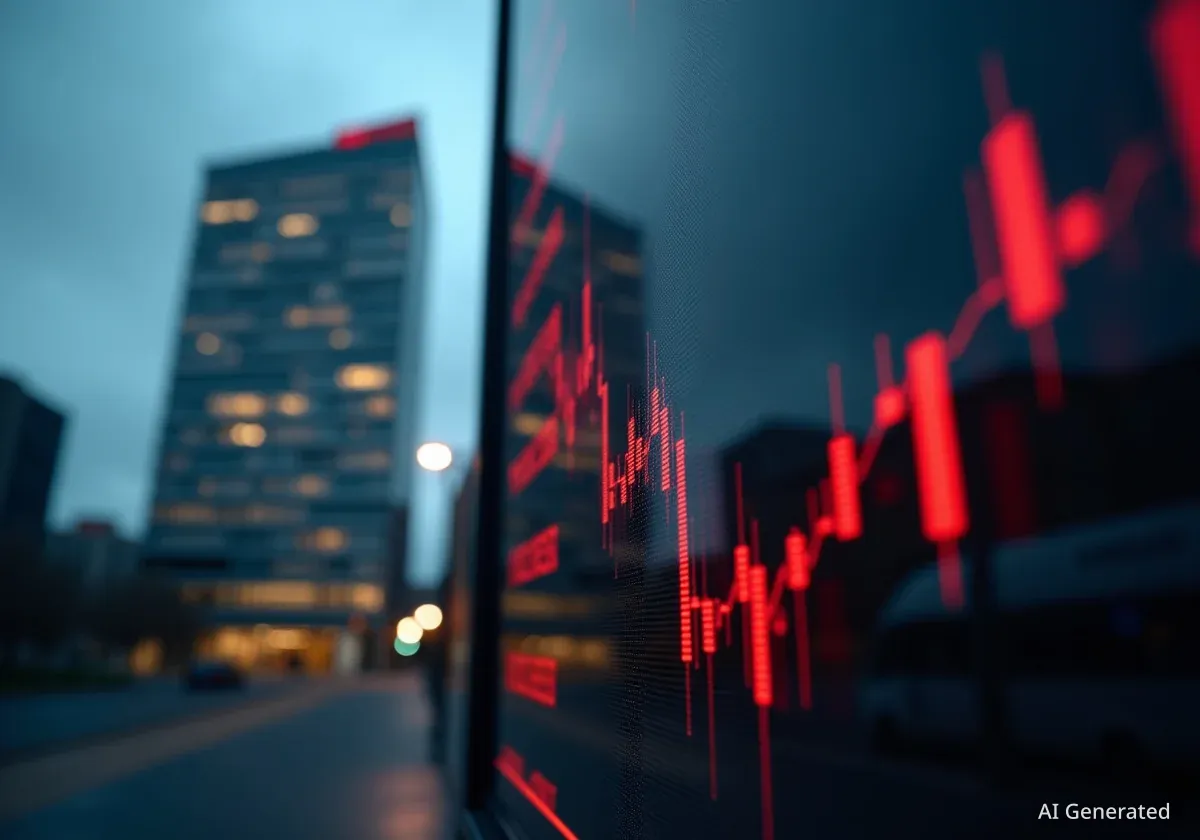Shares of Alexandria Real Estate Equities, Inc. (ARE), a major real estate investment trust focused on the life sciences sector, experienced a significant drop following the release of its third-quarter financial results. The company's stock fell from approximately $73 to nearly $53 per share, a move accompanied by a massive surge in trading volume, signaling a potential capitulation event among investors.
The sharp decline was triggered by quarterly results that fell short of market expectations and a downward revision of the company's full-year guidance. This has intensified concerns about the health of the life sciences real estate market, which is currently navigating several industry-wide challenges.
Key Takeaways
- Alexandria Real Estate's stock price dropped sharply after its Q3 2025 earnings report, which missed revenue and profit expectations.
- The company lowered its full-year 2025 guidance, citing challenging market conditions in the life sciences industry.
- Headwinds include an oversupply of lab space, a slow IPO market for biotech firms, and high interest rates.
- Despite the sell-off, the company maintains a high dividend yield of nearly 10%, although its future dividend strategy is under review.
- The dramatic increase in trading volume during the price drop suggests that many investors have sold their positions, which can sometimes precede a market bottom.
Understanding the Market Reaction
The investor response to Alexandria's latest financial report was immediate and severe. Prior to the announcement, the stock was trading around $73. In the days that followed, it plunged to a low of about $53 per share. This represents a significant loss of value in a very short period, extending a downward trend that has seen the stock nearly halve in value since the beginning of the year.
A key indicator of market sentiment was the extraordinary trading volume. On October 28, 2025, trading volume surged to over 12 million shares. This is nearly ten times the average daily volume of around 1.2 to 1.4 million shares seen just before the earnings release. Such a high volume of selling is often described as capitulation, a point where investors give up on a stock and sell in large numbers, often out of frustration or panic.
By the Numbers: The Sell-Off
- Pre-Earnings Price: ~$73 per share
- Post-Earnings Low: ~$53 per share
- Peak Trading Volume: 12.27 million shares on Oct. 28
- Average Volume Before Sell-Off: ~1.3 million shares
While such events create significant short-term pressure, some market analysts view them as potential indicators that the worst of the selling may be over. The logic is that once the most pessimistic investors have exited their positions, the stock may find a new, more stable price floor.
Disappointing Q3 Financials
The catalyst for the sell-off was a third-quarter report that failed to meet analysts' expectations. The company reported Adjusted Funds From Operations (AFFO) of $2.22 per share, missing the consensus estimate of $2.31 per share. Revenues also came in slightly below forecasts at $751.9 million, compared to an expected $754.4 million.
These figures also represented a decline from the same period last year, when the company posted revenues of $791.6 million in Q3 2024. In response to the performance and ongoing market conditions, Alexandria reduced its full-year 2025 guidance to $9.01 per share, down from a previous forecast of $9.26 per share.
The Dividend Question
A major point of concern for investors is the future of the company's dividend. Alexandria currently pays a quarterly dividend of $1.32 per share, which translates to an annual yield of nearly 10% at its recent low stock price. While this is an attractive return, such a high yield can also signal that the market anticipates a potential cut.
Management's comments in the earnings report added to this uncertainty. The company stated it would review its future dividend policy, which many investors interpreted as a warning of a possible reduction.
"In addition, as described in the '2026 Considerations' section of guidance, in light of market and life science industry conditions and our continued focus on capital efficiency, our Board of Directors expects to carefully evaluate our 2026 dividend strategy."
Despite this, the company's current payout ratio is approximately 57%, which is generally considered sustainable. For 14 consecutive years, Alexandria has increased its dividend, making any potential cut a significant shift in its long-standing strategy.
Navigating Industry Headwinds
The Life Sciences Real Estate Sector
Life sciences real estate involves developing and managing properties specifically designed for biotechnology, pharmaceutical, and medical research companies. These facilities, which include specialized labs and research campuses, have unique requirements that differentiate them from standard office or industrial properties.
Alexandria's challenges are not unique to the company but reflect broader trends affecting the entire life sciences real estate sector. Several factors are contributing to the current downturn.
- Oversupply of Lab Space: A construction boom during the pandemic-era biotech funding surge has led to an excess of available lab space in key markets, putting downward pressure on rents and occupancy rates.
- Weak Biotech IPO Market: The market for initial public offerings (IPOs) for new biotech companies has been slow. This reduces the formation of new, well-funded startups that would typically lease new lab space.
- Higher Interest Rates: Elevated interest rates increase the cost of capital for REITs like Alexandria, making it more expensive to finance new developments and acquisitions. It also affects property valuations across their portfolio.
Despite these issues, Alexandria reported some stable operational metrics in Q3. Same-property net operating income was at 90.6%, nearly unchanged from the previous quarter, and the company collected 99.9% of its rents.
Long-Term Outlook and Potential Opportunities
While the near-term outlook is clouded by market challenges, the long-term fundamentals of the life sciences industry remain a point of optimism for some. An aging global population and continuous advancements in medicine and technology are expected to drive sustained demand for research and development facilities.
Future interest rate cuts, which the Federal Reserve is anticipated to implement heading into 2026, could provide significant relief. Lower rates would reduce financing costs for Alexandria and could also reinvigorate the biotech IPO market, creating a new wave of tenants.
Furthermore, there is potential for Alexandria to adapt its extensive portfolio. Some analysts suggest its life science campuses could be repurposed to serve as large-scale data centers for AI-driven drug discovery or as specialized domestic manufacturing facilities for pharmaceuticals, aligning with national security goals of shortening supply chains.
However, significant risks remain. A broader economic recession could further dampen demand for lab space. The timeline for a recovery in the biotech sector is uncertain, and any dividend cut could be more substantial than investors currently anticipate. For now, the market is watching closely to see if this life sciences giant can navigate the current storm and reposition itself for future growth.





